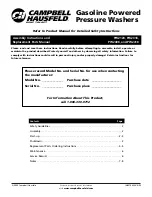
Removing stains
Stubborn stains may not be removed by just water and
detergent. It is therefore advisable to treat them prior to
washing.
Blood: treat fresh stains with cold water. For dried stains,
soak overnight in water with a special detergent then rub
in the soap and water.
Oil based paint: moisten with benzine stain remover, lay
the garment on a soft cloth and dab the stain; treat several
times.
Dried grease stains: moisten with turpentine, lay the gar-
ment on a soft surface and dab the stain with the fingertips
and a cotton cloth.
Rust: oxalic acid dissolved in hot water or a rust removing
product used cold. Be careful with rust stains which are
not recent since the cellulose structure will already have
been damaged and the fabric tends to hole.
Mould stains: treat with bleach, rinse well (whites and fast
coloureds only).
Grass: soap lightly and treat with bleach (whites and fast
coloureds only).
Ball point pen and glue: moisten with acetone
1)
, lay the
garment on a soft cloth and dab the stain.
Lipstick: moisten with acetone as above, then treat stains
with methylated spirits. Treat any residual marks with
bleach.
Red wine: soak in water and detergent, rinse and treat with
acetic or citric acid, then rinse. Treat any residual marks
with bleach.
Ink: depending on the type of ink, moisten the fabric first
with acetone
1)
, then with acetic acid; treat any residual
marks on white fabrics with bleach and then rinse thor-
oughly.
Tar stains: first treat with stain remover, methylated spirits
or benzine, then rub with detergent paste.
Detergents and additives
Good washing results also depend on the choice of de-
tergent and use of the correct quantities to avoid waste
and protect the environment.
Although biodegradable, detergents contain substances
which, in large quantities, can upset the delicate balance
of nature.
The choice of detergent will depend on the type of fabric
(delicates, woollens, cottons, etc.), the colour, washing
temperature and degree of soiling.
All commonly available washing machine detergents may
be used in this appliance:
• powder detergents for all types of fabric
• powder detergents for delicate fabrics (60°C max) and
woollens
• liquid detergents, preferably for low temperature wash
programmes (60°C max) for all types of fabric, or spe-
cial for woollens only.
The detergent and any additives must be placed in the
appropriate compartments of the dispenser drawer before
starting the wash programme.
If using liquid detergents, a programme without prewash
must be selected.
Your appliance incorporates a recirculation system which
allows an optimal use of the concentrated detergent.
Follow the product manufacturer’s recommendations on
quantities to use and do not exceed the «MAX» mark in
the detergent dispenser drawer .
Quantity of detergent to be used
The type and quantity of detergent will depend on the type
of fabric, load size, degree of soiling and hardness of the
water used.
Follow the product manufacturers’ instructions on quan-
tities to use.
Use less detergent if:
• you are washing a small load
• the laundry is lightly soiled
• large amounts of foam form during washing.
Degrees of water hardness
Water hardness is classified in so-called “degrees” of
hardness. Information on hardness of the water in your
area can be obtained from the relevant water supply com-
pany, or from your local authority. If the water hardness
degree is medium or high we suggest you to add a water
softener following always the manufacturer’s instructions.
When the degree of hardness is soft, readjust the quantity
of the detergent.
1) do not use acetone on artificial silk
10
Содержание ZWF 12380W
Страница 1: ...EN User manual 2 Washing Machine ZWF 12380W ZWF 14380W ...
Страница 25: ...25 ...
Страница 26: ...26 ...
Страница 27: ...27 ...
Страница 28: ...www zanussi com 192994970 00 232009 ...











































